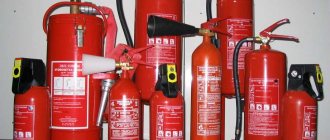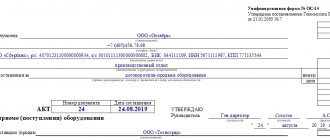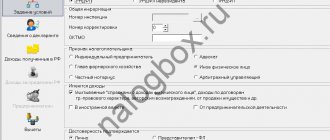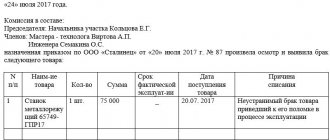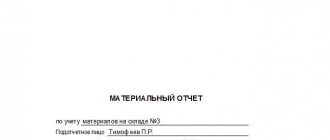Purpose of the document
A defect report is a document drawn up when checking means of production for defects. It is issued only when wear or damage is detected on the inspected equipment.
If there are no defects in the equipment, a defect report is not issued.
It is drawn up only when inspecting complex equipment for defects. Example: if there is a crack in a small wrench, documentary evidence of this fact is not required.
The presence of a defective report is a reason for repair or write-off of equipment. It is important that this official paper is compiled by specialists who can correctly assess the condition of the means of production. When writing off devices that need to be repaired, the question of unreasonable expenditure of funds arises. If an attempt is made to repair non-repairable equipment, control authorities have the right, for example, to file a request for violation of safety regulations.
Moreover, in the absence of a defective act, the expert inspection carried out has no legal force. Tax officials have the right not to recognize expenses for repairs or the purchase of new means of production as justified. Any decisions regarding the equipment in question are made only after a defect report has been issued. Moreover, there should be no errors in the design; because of them, the document may be declared invalid.
A defect report is drawn up in the following situations:
- Scheduled expert inspection of the condition of means of production.
- Check after installation of equipment. Usually carried out in case of complex installation.
- Quality control after repair of fixed assets.
- Acquisition of new means of production.
- The occurrence of production failures for unknown reasons.
If the object being checked for defects is under warranty service, a defect report must be drawn up upon decommissioning or repair. An expert assessment from the manufacturer is added.
What document is drawn up when a defect is discovered?
A defect report is a paper recording breakdowns, malfunctions and shortcomings in any equipment or object.
Such a document is related to the primary documentation and is based on the commission’s conclusion. It is the defective act that can be the basis for writing off the operating system or product, since it contains data regarding identified defects in the equipment, and the act also indicates the option for correcting them if the commission has determined that the equipment is subject to restoration.
Important: a defective act must be drawn up in accordance with all requirements, since its inaccurate formation often serves as a refusal by the tax service to recognize repair expenses, which will entail the accrual of additional taxes and fines.
The act does not contain the price of repair work or damage received; it is the basis for drawing up:
- Estimates for repairs;
- Report on the feasibility of repairs;
- An order to carry out repair work;
- Write-offs of worn-out objects. Here you will learn how to correctly draw up an order to write off fixed assets.
Important: the document must be generated if the equipment is under warranty or service.
You will learn how to correctly compose and edit a defective statement in this video:
https://youtu.be/A8VsAyAC08Q
Who draws up the act and when?
When equipment breaks down, a special commission is assembled to determine the circumstances and extent of the damage by order of the head of the organization, which is responsible for drawing up such documentation.
The document must be signed by all participants in the equipment inspection.
Compilation rules
There must be compelling reasons to issue a defective report. An employee of the organization, if there is a suspicion of defects in the equipment, reports to his superiors. And already the management issues an order for a thorough inspection of the means of production. The defect report must indicate a list of equipment to be checked. Then the order provides complete information about the composition of the commission, which is obliged to make an expert opinion on the issue under consideration.
The current legislation does not provide for a fixed form of a defective act.
But there are a number of requirements that the document must meet. In particular, it is necessary to comply with the provisions of Article 9 of Federal Law No. 402 “On Accounting”. Otherwise, the document is not accepted by the tax office.
The defective act must provide a reference to the corresponding order. It is necessary to provide the order number, the date of its signing and the responsible person. In the standard version, the order is issued by the director of the enterprise. Further, the defective act repeats information about the commission members. There are two options: either at the beginning of the document, or at the end, before the attachments.
Popular questions about this article
✅ What is a defective act?
A document that is drawn up when inspecting complex equipment for defects. For example, when inspecting a car.
✅ In what situations is a defective act drawn up?
A defect report must be drawn up in the following situations:
- Scheduled expert inspection of equipment condition;
- Checking the equipment after installation in case of complex installation;
- Quality control after repair;
- Purchasing a new product;
- The occurrence of production failures for unknown reasons.
✅ What information should the document contain?
The document must contain the following information:
- Description of the object being checked;
- List of defects - obvious breakdowns and potential defects;
- Conclusions of the commission.
✅ Who should be on the commission?
Here are the basic requirements for the composition of the commission, which should include:
- Workers involved in the operation of the equipment being tested;
- Repair department workers;
- Representatives of the department receiving the equipment;
- Accounting workers.
✅ Is the composition of the commission changing?
The composition of the expert commission varies depending on the type of object and the complexity of the assessment. For example, in the case of repairs of complex industrial equipment, only a specialist can provide an expert assessment. If the enterprise does not have a professional of the required category, he is brought in from outside.
Requirements for the content of a defective act
There are a number of provisions that a defective act must contain:
- Description of the object being checked. Identification numbers, appearance, etc. The description is drawn up so that a person unfamiliar with the equipment being tested can identify it without difficulty. All identification numbers and their locations must be listed.
- List of defects. In some cases, commission members separately note which of them found certain breakdowns or damage to the structure. Typically, defects fall into two main categories: Obvious, detected failures. Their presence does not require additional evidence. Example: a crack or deformation of a certain part. A detailed description of the breakdown and the probable causes of its occurrence are given. It is advisable to add an image of the breakdown in the applications.
- Potential defects. A group that is more difficult to detect. Here are the breakdowns that can occur if repairs are not carried out. Example: worn out machine transmission belt. He is still able to work. But without a quick replacement, it will certainly fail. This paragraph lists each potential defect, as well as the reasons for its occurrence.
Attachments to the defect report: documents for the relevant equipment or fixed assets, indicating the period and operating conditions. Material evidence of defects is also listed here - photographs, damaged final products, etc. At the end there are signatures of all commission members.
Requirements for the composition of the inspection commission
Separately, the composition of the commission involved in the expert assessment of problematic equipment should be listed. It should include the following persons:
- Workers involved in the operation of the equipment being tested. With their submission, the inspection and registration of a defect report begins, and they are the first to determine whether repairs or replacement of production means are required. In most cases, the commission includes a senior member of the department or division. Or they choose the most experienced specialist who is familiar with the type of equipment being inspected.
- Repair department workers. If the company has its own repair department, a representative of this department is selected. When checking equipment under warranty, a representative from the manufacturer is required. Repairers give an expert assessment of the scope of restoration work. They are required to provide a reasonable estimate for the restoration of equipment. If the means of production cannot be restored, the defect report lists the reasons why repair is impossible and write-off is required.
- Representatives of the department receiving the equipment. In some cases, these are controllers from the repair department. They are required to make an expert opinion on the presence of defects. And when restoring or decommissioning, make sure that the new or restored equipment operates in accordance with the requirements of the customer enterprise.
- Accounting workers. Their task is to record the costs of repair/replacement of equipment. After filing a defect report, their task is to prepare a report listing all expenses. Both the total amount and its components are indicated: delivery of spare parts, repair costs, production downtime, etc. When written off, the full cost of purchasing and delivery of equipment is indicated.
All information regarding the inspection persons is reflected in the defective act itself.
It is necessary to take into account: the composition of the expert commission varies depending on the type of object and the complexity of the assessment. Example: the feasibility of replacing a door can be assessed by a person who is not a specialist. If a crack appears in the jamb, cosmetic repairs are sufficient. And if the door splits in two, then replacement and decommissioning are necessary.
The situation is different in the case of repair of complex industrial equipment. Here only a specialist can give an expert assessment. If the enterprise does not have a professional of the required category, he is brought in from outside. The defective act must include his signature, full name, and place of work. Additionally, arguments in favor of restoration or write-off and replacement are listed.
https://youtu.be/m_l46-rlhxQ
Nuances
The equipment defect detection procedure is carried out in order to professionally examine its technical condition. Thanks to such events, business entities are able to obtain accurate data on the current state of technical devices. This information allows you to make a decision on the advisability of further operation of the equipment.
Important! The work of the expert commission allows the manager to obtain accurate information about upcoming expenses. He will be told the amount of the upcoming repairs, and he will assess the financial capabilities of the organization.
If the company has a sufficient amount of funds in its account, then repairs can be carried out immediately. In the absence of money, work on restoring the equipment will have to be postponed, or investors will have to be involved in this process.
Post Views: 6,265
One comment on ““Defective equipment report””
- Eugene:
03/07/2018 at 13:45
Contractor. ACCORDING TO THE AGREEMENT, he began repair work. He discovered defects not taken into account in local estimates. Who should draw up a defect report? Best regards, Evgeniy
Answer
Sample of filling out a defect report
As an example, it is worth considering a defect report drawn up when a car gearbox breaks down in a transportation organization. The described option is suitable for any vehicle component. It looks like this:
- Name. Options: “Certificate of vehicle defects”, “Defective report for car repairs”, “Certificate of technical condition of the vehicle”. If necessary, the node name is indicated, but this is optional.
- Information about the date of drawing up the defect report. Below is the place where the document is executed - the locality and the exact address.
- Information about the inspectors is listed. The commission responsible for the defect report usually includes an auto mechanic of the enterprise and a representative from the accounting department. Optionally, a representative of the car manufacturer is included in the expert commission if it is under warranty. Often the driver of the vehicle is also the inspector.
- Reasons for carrying out the inspection and issuing a defect report.
- Information about the car available to the owner.
- Information about the car available to repairmen. The item is turned on optionally in case of repairs at a third-party service station.
- Vehicle registration data. It is mandatory to provide combinations of numbers marked on the license plates, the number of the car itself, obtained at production, and the license plate number. There should be no discrepancies between the car's passport and the defect report.
- Inspection results. This paragraph of the document lists the defects found and the probable causes of their occurrence.
- Verification deadlines. The start and end date of the inspection of the defective manual transmission is indicated. It should not be confused with the date of drawing up the defective act.
- List of tools used when inspecting a car. Then the verification methods are necessarily described. If necessary, step by step.
- Conditions for conducting an inspection and drawing up a defect report. In particular, the room where the inspection was carried out is described. Obstacles for verification, if any, must be indicated.
- Advice and recommendations of commission members. It is written whether the unit requires replacement or repair. If repairs are necessary, it indicates what needs to be done to restore the car’s manual transmission. It is advisable to give recommendations on the correct operation of the vehicle.
- Applications. Receipts (inspection fees, new parts, etc.), photographs of defective parts, and expert opinions of commission members recorded in writing are provided here.
- Signatures of the commission members who drew up the act. The chairman of the commission must also be indicated here. A transcript of the signatures and full name are required.
Please note: in the event of serious breakdowns, the commission should be led by the chief mechanic of the enterprise or another responsible person from management. However, the rest of the commission may not change.
During comprehensive inspections, a defect report is drawn up separately for each object inspected.
Requirements for the composition of the inspection commission
The expert commission for carrying out defect detection is appointed by the head of the organization (the owner of the asset) by order. The commission must include:
- Representatives of the organization that owns the asset: technical specialists, workers who directly use the inspected object and identified the defect, representatives of accounting and administration (the owner), quality control department employees and other employees if necessary.
- Representatives of interested parties: suppliers, buyers, contractors, transporters, manufacturers, specialists from repair organizations and other interested parties.
- Experts. It is advisable to involve third-party, independent specialists.
In the work of the commission, a material person is necessarily involved, in charge of the object being examined. The composition of the commission largely depends on the purpose of drawing up the DA and is individual in nature. If it is planned to file a claim in the future, then the participation of representatives of the defendants is mandatory. If the issue of a technical breakdown is being resolved, then often it is enough to involve specialists from your organization (without outside participation).
The absence of representatives of the interested party may lead to the recognition of the results of the commission's work as invalid.
Download documents
As a possible option for filling out, it is recommended to pay attention to forms OS-2 and OS-3.
Form OS-2 is used for internal movement of fixed assets - in particular, from production to the repair department. And the OS-3 form is used in the case of drawing up a transfer and acceptance certificate for repaired equipment.
Equipment defect report WORD
1 file(s) 32.00 KB
Download
Sample equipment defect report WORD
1 file(s) 34.50 KB
Download
Defective act on write-off of fixed assets WORD
1 file(s) 41.00 KB
Download


